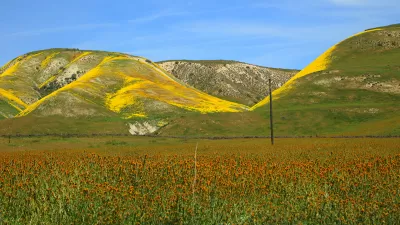CA's Air Resources Board approved another 'first' - a low carbon fuel standard that will play a key role in meeting the state's aggressive climate action plan by reducing the carbon intensity of transportation fuels. Winners and losers are created.
"California's Air Resources Board on Thursday approved (9-1) a first-in-the-world regulation to minimize the amount of carbon in fuel, putting California on the cutting edge of promoting alternative fuels in a bid to combat global warming.
The regulation will require fuel manufacturers to cut the so-called carbon intensity of fuels sold in the state 10 percent by 2020.
Gov. Arnold Schwarzenegger initiated the process for the standard with an executive order in 2007.
Manufacturers can meet the standard by selling a mix of fuels, selling all low-carbon fuels or using credits that can be both bought and earned from the state if they exceed the limitations. Alternative fuels include electricity, natural gas, biofuel from food products and fuel from algae, among others.
At the all-day public hearing before the vote, backers of corn-based ethanol criticized the regulation because it counts - as part of the carbon intensity - the indirect effects of manufacturing the fuel. With corn-based ethanol, that means counting the impact of creating new crop land when existing land is converted to growing corn for fuel instead of food.
Representatives of big oil companies were split on the proposal, with Chevron supporting, BP neutral and Tesoro opposing. Large utilities, including PG&E and Southern California Edison, expressed strong support, along with scientific, health and environmental advocacy organizations."
Thanks to MTC-ABAG Library
FULL STORY: Air Resources Board moves to cut carbon use

Planetizen Federal Action Tracker
A weekly monitor of how Trump’s orders and actions are impacting planners and planning in America.

Restaurant Patios Were a Pandemic Win — Why Were They so Hard to Keep?
Social distancing requirements and changes in travel patterns prompted cities to pilot new uses for street and sidewalk space. Then it got complicated.

Map: Where Senate Republicans Want to Sell Your Public Lands
For public land advocates, the Senate Republicans’ proposal to sell millions of acres of public land in the West is “the biggest fight of their careers.”

Orange County, Florida Adopts Largest US “Sprawl Repair” Code
The ‘Orange Code’ seeks to rectify decades of sprawl-inducing, car-oriented development.

Maui's Vacation Rental Debate Turns Ugly
Verbal attacks, misinformation campaigns and fistfights plague a high-stakes debate to convert thousands of vacation rentals into long-term housing.

San Francisco Suspends Traffic Calming Amidst Record Deaths
Citing “a challenging fiscal landscape,” the city will cease the program on the heels of 42 traffic deaths, including 24 pedestrians.
Urban Design for Planners 1: Software Tools
This six-course series explores essential urban design concepts using open source software and equips planners with the tools they need to participate fully in the urban design process.
Planning for Universal Design
Learn the tools for implementing Universal Design in planning regulations.
Heyer Gruel & Associates PA
JM Goldson LLC
Custer County Colorado
City of Camden Redevelopment Agency
City of Astoria
Transportation Research & Education Center (TREC) at Portland State University
Camden Redevelopment Agency
City of Claremont
Municipality of Princeton (NJ)



























